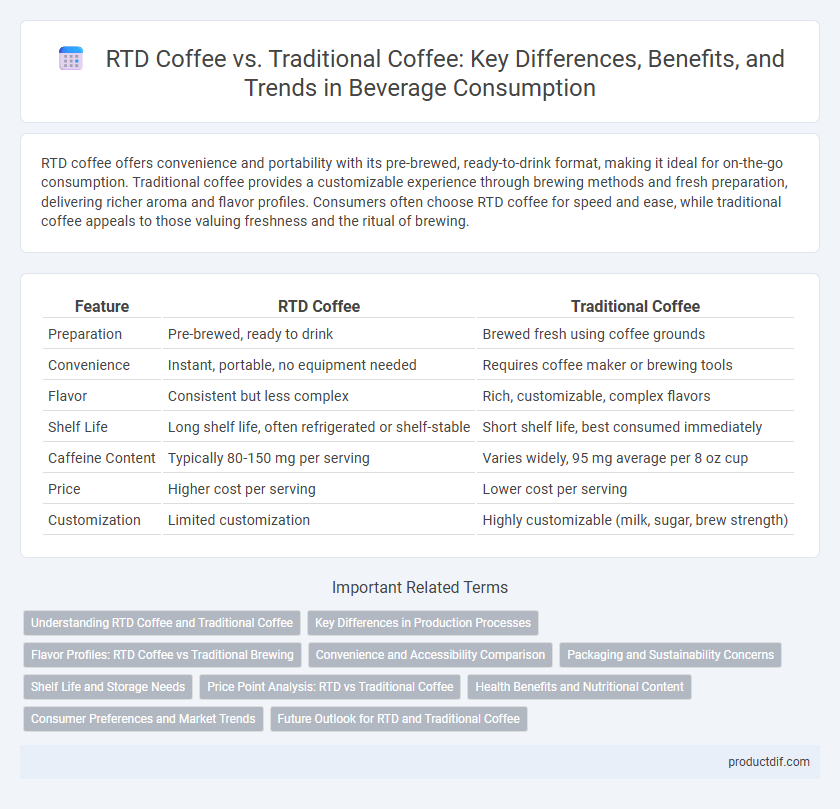RTD coffee offers convenience and portability with its pre-brewed, ready-to-drink format, making it ideal for on-the-go consumption. Traditional coffee provides a customizable experience through brewing methods and fresh preparation, delivering richer aroma and flavor profiles. Consumers often choose RTD coffee for speed and ease, while traditional coffee appeals to those valuing freshness and the ritual of brewing.
Table of Comparison
| Feature | RTD Coffee | Traditional Coffee |
|---|---|---|
| Preparation | Pre-brewed, ready to drink | Brewed fresh using coffee grounds |
| Convenience | Instant, portable, no equipment needed | Requires coffee maker or brewing tools |
| Flavor | Consistent but less complex | Rich, customizable, complex flavors |
| Shelf Life | Long shelf life, often refrigerated or shelf-stable | Short shelf life, best consumed immediately |
| Caffeine Content | Typically 80-150 mg per serving | Varies widely, 95 mg average per 8 oz cup |
| Price | Higher cost per serving | Lower cost per serving |
| Customization | Limited customization | Highly customizable (milk, sugar, brew strength) |
Understanding RTD Coffee and Traditional Coffee
RTD coffee, or Ready-To-Drink coffee, offers convenience through pre-packaged, chilled beverages that combine brewed coffee with milk, sweeteners, or flavors, catering to on-the-go consumers. Traditional coffee involves freshly brewed coffee from ground beans, allowing customization in brewing methods, strength, and flavor profiles, often enjoyed hot or freshly prepared. Both RTD and traditional coffee vary in caffeine content, shelf life, and freshness, influencing consumer preference based on lifestyle and taste requirements.
Key Differences in Production Processes
RTD (Ready-to-Drink) coffee undergoes brewing, filtration, and sterilization before being packaged in cans or bottles to ensure extended shelf life and convenience. Traditional coffee involves grinding fresh beans and brewing immediately using methods such as drip, espresso, or French press, preserving maximum flavor and aroma. The RTD process emphasizes mass production and consistency, while traditional coffee prioritizes freshness and customization.
Flavor Profiles: RTD Coffee vs Traditional Brewing
RTD coffee offers consistent flavor profiles with smooth, balanced notes due to controlled manufacturing processes, while traditional brewing emphasizes freshness and allows for diverse taste variations influenced by bean origin, grind size, and brewing method. RTD coffee tends to highlight sweeter, creamier flavors with lower acidity, whereas traditional brewing often produces bolder, more complex flavors with nuanced aroma profiles. Consumers seeking convenience may prefer RTD coffee's predictability, while enthusiasts favor traditional brewing for its customizable and richer sensory experience.
Convenience and Accessibility Comparison
RTD coffee offers unparalleled convenience with its ready-to-drink format, eliminating the need for brewing and allowing consumers to enjoy quality coffee anytime, anywhere. Traditional coffee requires preparation time, specialized equipment, and often limits accessibility to home or cafe settings. RTD coffee brands have expanded distribution through grocery stores, vending machines, and online platforms, significantly enhancing consumer access compared to conventional coffee purchases.
Packaging and Sustainability Concerns
RTD coffee packaging often uses recyclable aluminum cans and PET plastic bottles designed for convenience and portability, while traditional coffee relies on paper bags and glass jars that may have lower recyclability. Sustainability concerns highlight the environmental impact of single-use RTD containers, prompting brands to adopt eco-friendly materials and refillable options. Traditional coffee packaging, despite being bulkier, tends to generate less waste per serving, making it a preferred choice for environmentally conscious consumers.
Shelf Life and Storage Needs
RTD coffee offers a longer shelf life, typically lasting several months due to pasteurization and airtight packaging, whereas traditional coffee beans or grounds require careful storage in a cool, dark place to maintain freshness for up to a few weeks. RTD coffee demands minimal storage conditions, often shelf-stable at room temperature, while traditional coffee is prone to staling and oxidation if exposed to heat, moisture, or air. For consumers prioritizing convenience and longevity, RTD coffee provides a practical alternative without compromising flavor stability.
Price Point Analysis: RTD vs Traditional Coffee
RTD coffee typically commands a higher price point per serving due to packaging, convenience, and branding, with average prices ranging from $2 to $5 per bottle compared to traditional coffee, which averages $0.50 to $1.50 per cup made at home. Cost factors for RTD include processing, shelf stability, and distribution, while traditional coffee expenses involve raw beans, brewing equipment, and preparation time. Price sensitivity analysis shows consumers often pay a premium for RTD coffee's portability and ready-to-drink format despite higher per-unit costs compared to traditional coffee brewed from ground coffee.
Health Benefits and Nutritional Content
RTD (Ready-to-Drink) coffee offers convenient access to antioxidants and caffeine, supporting alertness and metabolism similarly to traditional brewed coffee. While traditional coffee contains minimal calories and can promote heart health through polyphenols, some RTD varieties may include added sugars or preservatives that affect nutritional value. Choosing RTD options with low sugar and natural ingredients maximizes health benefits comparable to freshly brewed coffee's nutrient profile.
Consumer Preferences and Market Trends
RTD coffee appeals to consumers seeking convenience, portability, and consistent flavor, driving rapid growth in urban markets with busy lifestyles. Traditional coffee remains favored for its freshly brewed taste and customization options, sustaining strong demand among coffee enthusiasts and specialty cafe patrons. Market trends indicate a rising preference for RTD coffee among younger demographics, while traditional coffee continues to dominate in-home and artisanal consumption segments.
Future Outlook for RTD and Traditional Coffee
The future outlook for RTD (Ready-to-Drink) coffee shows strong growth driven by consumer demand for convenience, innovation in flavor profiles, and increased adoption of functional ingredients like adaptogens and vitamins. Traditional coffee maintains steady popularity, particularly in cafe culture and specialty coffee sectors, supported by artisanal brewing techniques and sustainable sourcing trends. Market forecasts predict that RTD coffee will capture a larger share in the global coffee market due to urbanization, busy lifestyles, and expanded distribution through retail and e-commerce channels.
RTD Coffee vs Traditional Coffee Infographic

 productdif.com
productdif.com